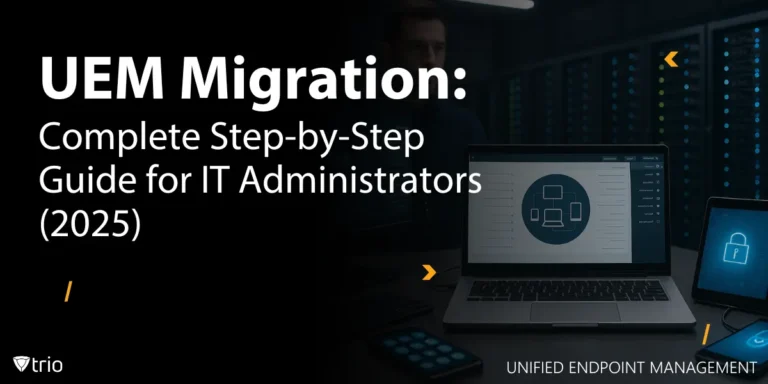IT support for IT administrators refers to the assistance and resources provided to those responsible for managing and maintaining an organization's IT infrastructure. IT administrators are professionals who oversee the day-to-day operations of an organization's computer systems, networks, servers, and other IT components. They play a crucial role in ensuring the smooth functioning of IT resources and addressing technical issues that may arise. In this blog we’ll cover everything you need to know for your business about IT support.
What Does IT Support Do?
Primarily, IT support involves troubleshooting and resolving technical issues that users encounter with hardware, software, and networks. Helpdesk management is central to this role, categorizing and prioritizing user-reported problems for timely resolution. IT support provides user assistance through various channels and often employs remote support tools for efficient problem-solving. This encompasses tasks such as software installation, hardware maintenance, and security management to protect IT assets. Additionally, IT support contributes to documentation efforts, maintaining comprehensive records for issue resolution and training purposes. Continuous improvement is a key focus, with IT support teams analyzing data and implementing proactive measures to enhance efficiency and stay abreast of evolving technologies. Overall, IT support plays a critical role in fostering a reliable and secure IT environment while supporting end-users and promoting organizational effectiveness.

How Can IT Support Benefit Your Company?
The benefits of IT support span across various dimensions. Firstly, it results in maximized company efficiency and productivity by ensuring the smooth functioning of the IT infrastructure. This leads to less time worrying and more time managing, facilitating productive work environments. Proactive issue resolution and efficient troubleshooting by IT support teams play a crucial role in preventing disruptions, translating to long-term cost savings and optimized operational processes.
Beyond operational aspects, IT support is pivotal in safeguarding the company's data security. By implementing and maintaining robust security measures such as access controls and encryption, IT support helps protect sensitive data and fortifies the organization against potential cyber threats. Additionally, IT support assists the company in adapting to technological changes by staying abreast of innovations and aiding in the adoption of new technologies to maintain competitiveness.
Furthermore, the positive impact extends to user productivity and satisfaction. Quick and effective resolution of IT issues ensures that employees can focus on their core responsibilities, enhancing overall job satisfaction and productivity. IT support also plays a strategic role in decision-making by providing valuable insights into the IT infrastructure, usage patterns, and areas for improvement. Compliance with industry regulations and standards, as well as risk management through the identification and mitigation of vulnerabilities, are additional areas where IT support contributes to the overall health and resilience of the company. Finally, through continuous improvement efforts, including user feedback, metrics analysis, and ongoing training, IT support helps the company adapt to changing needs, optimize processes, and enhance its IT infrastructure's overall effectiveness.
IT Support Processes
The IT support processes can be divided into certain sub-processes.
Incident Reporting and Tracking
Establishing a streamlined incident reporting system is essential for IT support to promptly address issues. This involves implementing user-friendly channels for reporting problems, such as a helpdesk or online portal, ensuring that users can easily communicate their concerns. Utilizing a ticketing system enhances efficiency in tracking incidents by assigning unique identifiers to each reported issue. This systematic approach allows IT support teams to prioritize and categorize incidents based on their severity and impact, enabling a more structured and organized response. By implementing these processes, organizations can create a responsive system that facilitates quick incident resolution and maintains a record of issues for future analysis and improvement.
Troubleshooting and Problem-Solving
Effective troubleshooting and problem-solving are at the core of IT support. This process begins with analyzing and diagnosing issues meticulously, using a systematic approach to identify the root cause of problems. IT support often leverages remote access tools, allowing technicians to troubleshoot and resolve issues directly on users' systems, reducing downtime and increasing efficiency. Collaboration with other IT teams is crucial, especially for complex issues that may span multiple systems or require specialized expertise. This collaborative approach ensures a comprehensive and effective resolution to technical challenges, contributing to the overall reliability and performance of the organization's IT infrastructure.
User Communication and Customer Service
User communication and customer service are integral aspects of IT support to ensure a positive user experience. Providing clear and timely communication to users involves keeping them informed about the status of their reported issues, expected resolution times, and any relevant updates. Offering friendly and helpful customer service is essential in creating a supportive environment. This includes empathetic interactions with users, actively listening to their concerns, and helping in a courteous manner. Managing user expectations involves setting realistic timelines for issue resolution and transparently communicating any challenges or delays. User satisfaction is a key metric, and effective communication and customer service contribute significantly to building trust and confidence in the IT support process, fostering a positive relationship between IT teams and end-users.
How IT Support Works: IT Support Levels
The number of levels in technical support can vary between organizations, and the terminology used may differ. However, a common structure involves three primary levels.
What is Level 1 Technical Support?
Level 1 or Tier 1 is the initial support level that handles basic and routine issues. Technicians at this level often follow predefined scripts or procedures to assist users with common problems. They are responsible for triaging issues and providing solutions or escalating more complex problems to higher support levels.
What is Level 2 Technical Support?
Level 2 (Tier 2) involves more experienced technicians who have a deeper understanding of the systems and can handle more complex technical issues. They often provide specialized support and may require a higher level of technical expertise. If Level 1 support cannot resolve an issue, it is escalated to Level 2.
What is Level 3 Technical Support?
Level 3 (Tier 3) is the highest level of technical support, usually consisting of experts with advanced knowledge in specific technologies or systems. Level 3 support deals with the most complex and critical issues that require in-depth technical expertise. If Level 2 cannot resolve an issue, it is escalated to Level 3.
Some organizations may have additional sub-levels or use different terminology, but the three-tier model is a common structure in technical support. The goal is to efficiently handle a variety of technical issues by assigning them to the appropriate level of expertise, ensuring a systematic and effective support process.
Integration with MDM Solutions
The integration of IT support with Mobile Device Management (MDM) solutions such as Trio marks a crucial advancement in organizational IT management, offering a comprehensive strategy for overseeing a diverse array of devices. This integration allows remote IT support resulting in efficiently troubleshooting and resolving issues, leveraging the centralized control provided by MDM for swift configuration adjustments, software updates, and security protocol enforcement. The collaborative approach extends to device and application management, where IT support seamlessly collaborates with MDM tools to ensure consistent configurations, adherence to organizational policies, and streamlined deployment of applications. This integration not only reduces the complexity of overseeing a myriad of devices but also significantly enhances the overall efficiency of IT support operations.
Moreover, coordinating MDM and IT support processes is deemed imperative for maximizing the benefits of integration. Effective collaboration between IT support teams and MDM administrators ensures the alignment of support processes with MDM capabilities. This coordination involves seamlessly integrating MDM functionalities into the broader IT support framework, synchronizing incident reporting, troubleshooting, and user communication processes with the centralized control provided by MDM. The outcome is a synergistic integration that optimizes device management, enhances overall responsiveness, fortifies security measures, and improves the efficiency of the entire IT support ecosystem.
Best Practices in IT Support
Maintaining best practices in IT support necessitates a holistic approach that encompasses several key elements. First and foremost, building a skilled and knowledgeable support team is foundational. This involves recruiting individuals with a diverse skill set, fostering ongoing professional development, and encouraging collaboration. A proficient team is equipped to handle the myriad of technical issues that may arise. Complementing this, implementing proactive monitoring and maintenance strategies is crucial. By leveraging monitoring tools, IT support can detect and address potential issues before they escalate, ensuring the uninterrupted functionality of IT systems. Regular maintenance activities contribute to system reliability and reduce the likelihood of unforeseen disruptions.
Continuous improvement is a dynamic component in the realm of IT support. This involves actively seeking and incorporating user feedback, analyzing support metrics, and iteratively refining processes. This feedback loop not only enhances the efficiency of issue resolution but also allows for the adaptation of support services to evolving organizational needs. Equally important is ensuring effective communication and timely response to user queries and reported issues. Clear and transparent communication builds user trust, manages expectations, and enhances overall satisfaction. Timely response, coupled with efficient issue resolution, contributes to a positive user experience, reinforcing the credibility and reliability of the IT support function. In combination, these elements form a comprehensive framework for maintaining best practices in IT support, ensuring a resilient and user-centric approach to technical assistance.

Conclusion
In conclusion, IT support, synonymous with technical support, plays a pivotal role in maintaining the seamless operation of an organization's IT infrastructure. From troubleshooting and helpdesk management to proactive measures, IT support ensures efficient problem resolution, system maintenance, and benefits such as operational efficiency and cost savings. The integration with MDM solutions streamlines device management, fortifying capabilities. The three-tier model in technical support ensures a systematic approach to handling diverse technical issues. The success of IT support lies in continuous improvement, encompassing a skilled team, proactive monitoring, and responsive communication, contributing to the ongoing resilience and adaptability of the organization's IT infrastructure.
Get Ahead of the Curve
Every organization today needs a solution to automate time-consuming tasks and strengthen security.
Without the right tools, manual processes drain resources and leave gaps in protection. Trio MDM is designed to solve this problem, automating key tasks, boosting security, and ensuring compliance with ease.
Don't let inefficiencies hold you back. Learn how Trio MDM can revolutionize your IT operations or request a free trial today!





